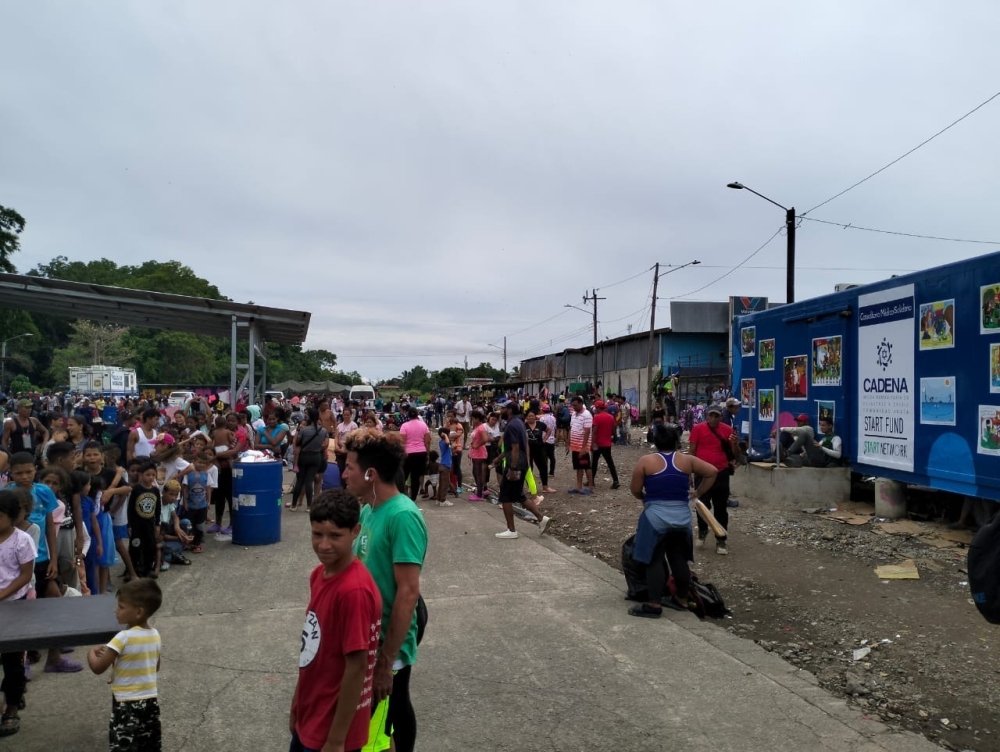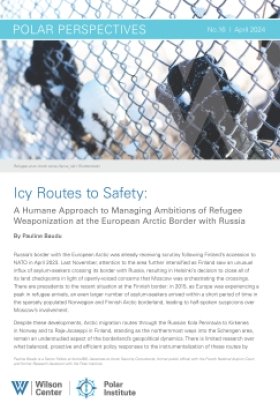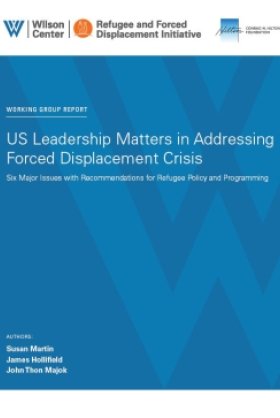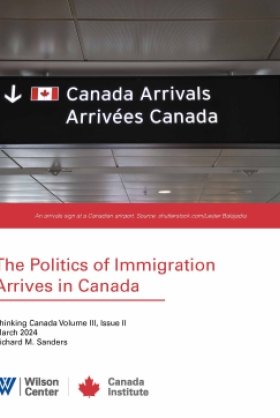Through the Darién Gap: A New Path for Chinese Asylum Seekers to the United States

Diego Palomo
Since the Immigration and Nationality Act of 1965, Chinese nationals have commonly entered the US via education programs or H1-B work visas. However, a quickly growing number is arriving via a new path: the southern border. Upon arrival, many claim political asylum, citing fears of President Xi Jinping’s authoritarian rule and the experience of draconian zero-COVID policies. Many also express skepticism of the Chinese economy and fears of eventually being cast into poverty.
For Chinese migrants, increasingly exclusionary immigration policies spurred by US COVID-era restrictions have cast doubt on historically reliable pathways such as education, work, or tourist visas. In 2021, Chinese B-visa applications saw a rejection rate of more than 79%. Though that number came down to 30% in 2022, the visa refusal rate to Chinese nationals has steadily increased from just 9% in 2014. Tourist visas have also become unfeasible for those eager to leave: the waiting time for an interview has risen to more than six months.
In the first nine months of 2023, the US Border Patrol made 22,187 arrests of Chinese nationals entering the country from Mexico. This was 13 times the number from the same period in 2022. Most of the previous figure stems from people traveling from much further south than Mexico. Over 15,500 Chinese migrants were counted in Panama after traversing a dangerous stretch of jungle beginning in Colombia known as the Darién Gap. This figure is nearly eight times as many from the same period in 2022, and more than 40 times that of 2021.
The US Border Patrol experienced record high numbers of migrant encounters at the US-Mexico border toward the end of 2023. Though the proportion of Chinese migrants is still relatively small when compared to other nationalities, they have become the fastest growing migrant demographic. To grasp the full picture of migration to the US today, policy makers must understand the migration drivers and routes, and asylum outcomes for those coming from non-traditional origin countries including China. An understanding of these factors will illuminate the role of social media, human rights violations, and underreported resettlement and integration patterns. Meaningful policy to address the rising numbers of Chinese asylum seekers will strengthen the US asylum system, impact the US’ relations with China, and increase the US’ global standing.
Zero-COVID Policy and Authoritarianism
China was one of the last countries to continue a zero-COVID policy. Geared toward acting “dynamically” when new cases surfaced, health authorities used tools such as mass PCR testing and digital health data tracking to justify supervised quarantines and even the shutdown of entire cities. In December 2021, the city of Xi’an, home to 13 million, was shut down, and residents were forbidden to exit their homes. In April 2022, an increase in cases of the milder Omicron variant triggered a lockdown of Shanghai and its population of more than 26 million. Residents waited in massive lines to stock up on goods with only several days’ notice. During the lockdown, many faced food shortages, pets were beaten to death on the streets for fear of transmitting the virus, and authorities entered homes unannounced to forcefully sanitize. In November 2022, frustrations over zero-COVID policy boiled over as cities across the country saw protests that, in their open expressions of anger and defiance, were rare for China. Chants of: “Step down, Xi Jinping! Step down, Communist Party!” were heard amongst crowds in Shanghai. “We don’t want lifelong rulers. We don’t want emperors!” was heard in Chengdu, a criticism of Xi Jinping’s unprecedented third presidential term.
Despite an end to zero-COVID in December 2022, a decision that was accelerated by these protests, the disillusionment felt by many persisted. Though repression by the government in Beijing is not a new phenomenon, the experience of constant surveillance and unexplained quarantines struck a more personal chord. Reporting along the US-Mexico border revealed this to be a major driver for Chinese migrants. "Zero-COVID policies severely harmed ordinary Chinese people…many people didn't care about politics before, but the pandemic awakened them. They realized there's really no freedom in China," immigration expert Zheng Cunzhu told Axios. Zheng has advised more than 100 such migrants.
Economic Drivers
Despite the end to zero-COVID, China’s economic recovery has been turbulent. In the second quarter of 2023, the GDP grew by just 0.8%. A contributing factor has been the centralization of economic policy, manifesting in regulatory crackdowns on fast-growing industries such as technology, financial services, and private education. The slowdown in the macroeconomy coincides with frustrations among the Chinese middle class about a depleted job market. In 2021, seven in ten unemployed urbanites held degrees, and the youth unemployment rate in June 2023 was 21.3%. With few professional opportunities available, university graduates have taken temporary jobs including as delivery drivers.
Data from migrant detentions suggests that while some fleeing China to the US-Mexico border are working class, many come from middle class backgrounds: Chinese migrants typically spend between $5,000 and $7,000 for self-guided trips, and up to $35,000 for the aid of smugglers, three times what Latin American migrants typically pay. Small business owners who were hit hard by pandemic restrictions, teachers and professors, and white-collar workers are among detainees.
Through the Darién Gap
During the lockdown of Shanghai, a new term gained steam online. Runxue is a combination of the Romanized character 润 which sounds like “run” and the character for study, xue (学). The pun translates to “runology.” As more and more people sought ways to practice runxue, the emergence of the Darién Gap as a way of escape flooded social media channels. Though this path was once virtually unknown beyond migrants from Latin America, posts on Weixin (WeChat), Douyin (TikTok), and Telegram taught Chinese viewers how to apply for passports, where to fly, how to pack, and how to navigate around cartels and border officials. In the more than two dozen Mandarin-language interviews conducted by Reuters at the US-Mexico border, every respondent credited social media and private internet groups for how they learned about this new route to the US.
Flying to Ecuador where they are not required to present a visa, Chinese migrants gather with migrants from across Latin America at Colombia’s northern border. Assessments from the International Organization for Migration (IOM) estimate that crossing to the Panamanian side can take up to ten days for the most vulnerable. Migrants are not only exposed to natural hazards, but also violence from bandits and from fellow migrants. Since 2014, the IOM has verified the deaths and disappearances of 379 migrants travelling through the Darién Gap. Because of the lack of official data, difficulty accessing the area, and little media coverage, most migrant deaths and disappearances in the jungle remain unverified. Recordings of deaths and disappearances are likely biased towards high-profile incidents and should be treated as underestimates of the true number of fatalities. From the verified records, the primary cause of death is drowning, although other causes include lack of shelter, hunger, dehydration, illness, and violence. While social media can help provide migrants with valuable information about the journey, it can also convey an inaccurate picture of the dangers they will face. Facebook pages of self-proclaimed travel agencies advertise the trek as an “exciting journey” and make bold promises of safe passage. In a TikTok post viewed more than 13 million times, vignettes of smiling and waving migrants, some jumping into pools of water to cool off, set optimistic expectations of the crossing.
After registering with authorities in Panama, migrants continue their journey via car or bus to the US-Mexico border. Still getting advice from social media, they may contact smugglers who deliver them to drop-off points inside the US. They are then instructed how to surrender to border patrol officers, who have had to quickly adapt to the challenge of processing Chinese-speaking asylum seekers. Most are released with an immigration court date after several days of detention.
Asylum and Integration
About 70% of Chinese asylum applications decided in 2023 were adjudicated through the affirmative process, as opposed to 16.3% across all nationalities. This indicates that most Chinese migrants claim asylum as they arrive. Most Chinese cases are adjudicated in New York, where more than 17,000 are on backlog. Where do these asylum seekers go as they await their court dates? What resources and opportunities exist for them, and how are they received by their communities?
New York City is a top destination for migrants from all nations, offering many city resources including over 200 shelters. However, Chinese migrants rarely opt for these; instead, they choose to go to neighborhoods with large Chinese populations. By living in these longstanding Chinese enclaves, newcomers can find housing, jobs, and immigration lawyers through community networks without needing to speak English. The self-sustaining character of urban Chinese American communities is true across the country. In Los Angeles, newcomers find housing in packed “family hotels,” which host up to 10 people to a room with upwards of 30 sharing a bathroom.
Where informal networks are insufficient, community centers and nonprofit organizations help fill the gap. In Chicago’s Chinatown, the Pui Tak Center provides services such as reading and translating mail, scheduling medical appointments, and help filling out immigration forms. Pui Tak Center Executive Director David Wu explained that their popular English classes provide language training and introduce new arrivals to city resources. The center began new classes in January teaching over 600 students. 140 of these students were new, and over half of these were recent migrants. Students learn about a wide range of resources including housing, healthcare, and public transportation.
Despite the self-reliant nature of new arrivals, the reception from the pre-existing Chinese community has been mixed. Wu pointed to linguistic differences and different immigration pathways among other factors that reduce sympathy. In the 1980s, 9 in 10 new immigrants to Chicago’s Chinatown spoke Cantonese. However, most of the new arrivals from China today are Mandarin speakers. Legal status has also been a point of contention, as those who arrived years ago on work and education visas may complain about “border crossers” who come by “walking the jungle,” phrases that have entered Chinese American lexicon.
Despite this mixed reception, the outlook is largely positive for Chinese asylum seekers in terms of their actual cases. In December 2023, the approval rate for Chinese asylum applications was 73.7% (87.2% in New York City). This is a significantly higher rate than the 48.5% average of all applications across the US that were accepted in December. Even when an application is denied and all appeals are exhausted, it is highly unlikely that a Chinese migrant is deported. Of all people with deportation orders in the US, 1 out of 13 are Chinese. However, China is particularly uncooperative when taking back deportees as the US cannot leverage aid, as it has with other origin countries.
Media Narratives
As Chinese migrants continue to make the journey over multiple countries and across miles of jungle to arrive at the US border, rumors are spun about their motivations for arriving. Some news media and political figures have described the phenomenon as an influx of “military age men,” stoking fear of these migrants having ties to China’s military or allegiance to the Chinese Communist Party. In a speech on January 31, 2024, House Speaker Mike Johnson (R-LA) discredited factors such as a repressive government, political and religious persecution, and economic fears, saying “these [Chinese migrants] are not huddled masses of families seeking refuge and asylum."
This narrative is misleading for a variety of reasons. US Customs and Border Protection does not publish data on the gender or age of migrants encountered. Because China does not compel military service from its citizens, and “military age” means different things in different countries, such phrasing is both unsupported by data and too broad to be a meaningful classification. It is unsurprising that younger, single adult men would be the most likely to travel a route as physically demanding as the Darién Gap. Young people are also more likely to be well-versed in social media, the primary source of information for Chinese migrants travelling through Central America. Clayton Dube, senior fellow at the University of Southern California US-China Institute, put it succinctly in an interview with PolitiFact: there is no proof that Chinese migrants arriving at the US are “motivated by anything other than individual desire to forge new lives in the US."
Ways Forward
Ironically, these narratives which target domestic fears of the Chinese geopolitical rival ignore opportunities to improve US standing in its competition with China. To take seriously the claims of political persecution would also reaffirm US standing as a global leader for human rights. China has long been considered recalcitrant in repatriating Chinese nationals with deportation orders from the US. This unwillingness to accept their nationals has been seen as a political tool, for example, something that can be leveraged against the US when it engages with Taiwan. Rather than alienating people in search of political, religious, and economic freedom—values that the US espouses on the world stage—the US should take advantage of the benefits that come with resettling refugees, defanging this threat.
Access to Regular Pathways
Heightened barriers to obtaining work and education visas for Chinese students and professionals have increased the pressure to find alternative routes. Chinese nationals are the primary source of international students in the US, but the student visa refusal rate in 2022 was an unprecedented 35%. These refusals come after students are already accepted to an accredited university. According to the Cato Institute, these refusals from 2022 will amount to an estimated loss of $26.4 billion in tuition payments and living expenses for the US economy over four years. For Chinese nationals applying for employment-based visas, some backlogs stretch as far back as 2013.
To address this, the US should expand access to F-1 student visas and H-1B visas across the board. In 2024, USCIS saw a huge increase in the number of H-1B visa applications. However, only 188,400 selections were made out of a pool of 758,994 eligible applicants. This constitutes a rejection rate of over 75% for 2024, compared to a 57% rejection rate in 2022. By providing greater access to regular, documented routes, encounters with US Customs and Border Protection officers and the backlog of asylum cases would be reduced.
A groundbreaking study recently published by the Department of Health and Human Services revealed that refugees and asylees generated $123.8 billion in net fiscal benefit to the US economy and government budgets from 2005-2019. Reporting from the southern border suggests that integrating Chinese migrants into the US economy would prove additionally beneficial. According to data from the US Census Bureau, Chinese immigrants employed in the US civilian labor force are 17% more likely than US-born workers to be employed in management, business, science, and arts occupations. Though this figure does not account for undocumented immigrants, many of the Chinese migrants arriving to the US-Mexico border come from highly educated or business backgrounds that would qualify them for these same occupations if given access to regular pathways.
Managing the Flow of Migrants
To better manage the flow of migrants to the US southern border, federal agencies should establish a robust presence across social media. Social media has become a primary source of information for migrants and asylum seekers. The Department of State boasts official accounts on Twitter, Instagram, Facebook, and YouTube, but their messaging cannot keep pace with that of “influencers” and potential bad actors. Agencies such as the Department of State and the Department of Homeland Security must establish a greater presence on a wide range of social media, including platforms that Chinese migrants commonly use such as WeChat and TikTok. Despite the ban of TikTok on government devices and efforts to ban the use of WeChat and TikTok, it is important for US agencies to find ways of providing accurate and accessible information about the risks and dangers of different migration pathways on the platforms most used by migrants.
Providing the resources for Chinese language training for US Customs and Border Protection officers at the southern border is also urgent. With the influx of Chinese migrants arriving alongside more migrants from across Latin America, it is essential to minimize delays that the language barrier may pose to an already strained registration process.
Improving Integration
Following their arrival, three tiers of resources help integrate migrants: informal and personal networks, community centers and nonprofits, and city and state services. Because many newcomers hesitate to enroll in government services that they qualify for, it is important to strengthen partnerships with community centers that can bridge the gap. A model to replicate is the Illinois Welcoming Center (IWC), a consortium of community centers, which includes the previously mentioned Pui Tak Center, which supports immigrants across backgrounds. Sponsored by the Illinois Department of Human Services, the IWC connects newcomers to health care, job-training, nutrition, and cash assistance programs regardless of immigration status.
About the Author


Refugee and Forced Displacement Initiative
The Refugee and Forced Displacement Initiative (RAFDI) provides evidence-based analyses that translate research findings into practice and policy impact. Established in 2022 as a response to an ever-increasing number of people forcibly displaced from their homes by protracted conflicts and persecution, RAFDI aims to expand the space for new perspectives, constructive dialogue and sustainable solutions to inform policies that will improve the future for the displaced people. Read more









